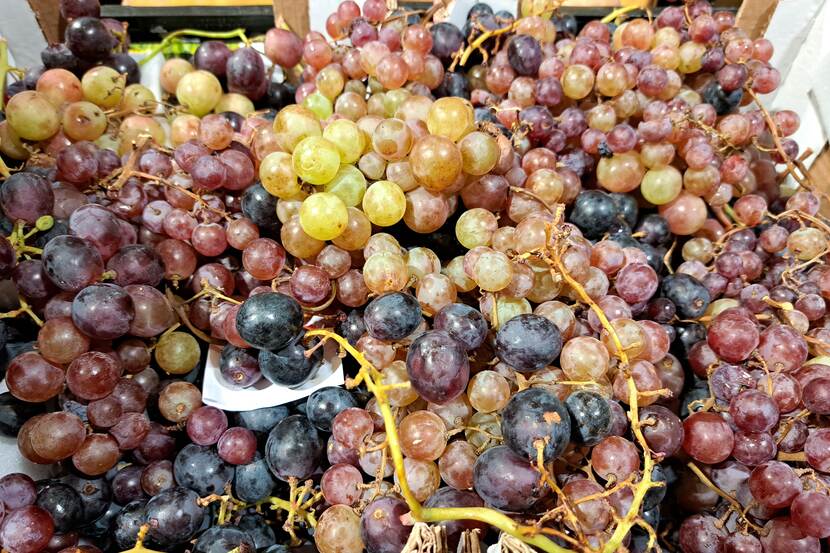Hungary: Time has come for growers to consider an overlooked fruit
Table grapes more viable as other fruit crops flater due to climate change; beekeers struggle from economic and climatic pressures; corn production hit by toxins; important season in nature reservation and game management starts - Our weekly briefing on agriculture, food and nature news in Hungary.

Table grapes might become an important Hungarian fruit
Winemaking is not the only reason to cultivate vineyards in Hungary, and this will become more and more true in coming years. This was one of the conclusions of a professional panel at the third annual table grape exhibition and competition at the Pécs Viticulture and Winemaking Research Institute, the National Chamber of Agriculture (NAK) reported this week.
Grape breeding expert András Korpás has highlighted in his panel that breeding resistant cultivars in Central Europe is difficult, since the region’s climate fluctuates between Atlantic, continental and Mediterranean patterns. In the past, various iconic varieties have been bred. Meanwhile, the main table grape varieties grown in the country have been imported from arid, irrigated and deserted regions.
Various experts agreed that while grape cultivation, especially for wine making, is very popular in Hungary, the research of table grape varieties has been mostly neglected for decades. While many fruit varieties will suffer more and more as the changing climate ushers in a new era, the time has come for other fruits, including table grapes, which are now more viable than any time in the past hundred years, reports NAK.
Hungarian beekeepers on the brink
Agrárszektor.hu published an interview with László Bezzeg of the Hugarian Professional Beekeepers Association earlier this week.
The impact of previously duty-free imported Ukrainian honey is still being felt in the market, according to Mr Bezzeg. Although Ukrainian honey can now only be imported with the payment of customs duties, it’s almost impossible to compete with the price of the more than 44,000 tons of honey that entered the market duty-free, says the expert.
The news portal highlights that due to the imported Ukrainian honey, as well as „counterfeit honey coming from Asia,” Hungarian producers can’t compete in the market. From 2014 to 2020, there was no significant change in the purchasing price, which hovered around €2-2.25 per kilogram. However, by 2021, there was a considerable incline, with the average purchasing price of honey reaching €3.11/kg. This increase continued into 2022, when the price was €3.53/kg. In 2023, however, there was a huge price drop, with the purchasing price of honey falling to just €2.32/kg.
Agrárszektor.hu also reported on the export market. Two-thirds of the 15 to 30 thousand tons of honey produced annually in Hungary is exported to the EU common market, where it has to compete with the 160-190 thousand tons of third-country imported products. However, according to State Secretary Zsolt Feldman, “Extremely cheap counterfeit products from Asia and Ukrainian honey are pushing Hungarian honey out of export markets, which is also driving down domestic sales prices.”
Corn hit hard by toxins, Hungary will need imports this year
We have previously reported on how corn was hit by the summer drought in July, and how the effects of the drought started to show on Hungary’s GDP in the latest data from Q2. However, the latest news indicate that further complications arose with the corn harvest. OTPAgrár.hu reported this week that toxins are affecting a large portion of the maize harvest.
According to a leading expert, many producers mix their aflatoxin-contaminated batches with high-quality ones, but this only results in “one large pile of poor-quality product”, making it much harder to sell.
It seems that, as with many other problems in agriculture, the changed climate is to blame for the current situation. Past experience shows a connection between toxin production and temperature. If it stays above 35°C for an extended period and the corn remains in the fields, the Aspergillus fungus present in corn starts producing aflatoxin. Moreover, this year’s situation shows that it doesn’t matter whether the crop was damaged by cotton bollworm or not—any plant or plot can become infected.
Although only 50-60% of the corn has been harvested in Hungary, it's already clear that 40% of this amount is contaminated with toxins, and there are serious issues with its quality. It seems that despite a harvest yield of around 5 million tons this year, Hungary will still need to rely on imports.
Nature and game management: Deer mating season starts
Agrárszektor.hu recently reported on the commencing deer mating season. For nature lovers, the mating season of deer makes fall hikes a unique experience, as the mating calls of stags can be heard throughout Hungary’s forests.
However, the fall season also makes deer collisions on roads more frequent because the animals are more active but less attentive in this period.
The portal reports that 194 million birds and 29 million mammals are killed on the roads of Europe every year. In Hungary, in the past year, 8,111 European hares, 5,625 roe deer, 5,364 pheasants, 840 red deer, 286 wild boars, 258 fallow deer, 54 grey partridges, and 13 mouflons were killed due to reported vehicle collisions. The most red deer were struck in Vas and Veszprém counties, while the most roe deer were hit in Bács-Kiskun and Vas counties.
The hunting season for red deer coincides with the rutting season. In the past hunting season, a record 88,501 red deer have been marked for hunting in Hungary, representing a 9% increase compared to the previous year.
The increased hunting in recent years has not caused a significant or visible decline in the population, the size of which is potentially between 250,000 and 300,000, according to the latest report by the National Game Management Database.
Hunting is an important part of not just game management but also nature conservation in Hungary, as with a lack of natural predators, only human intervention can maintain large game populations and the ecological balance of natural habitats.